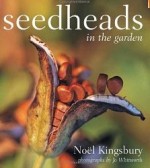 Few people are not touched by the color and textures of the spring and summer garden but how many see beauty in the brown remains when the good weather has passed? For sure, some people have an appreciative eye that sees the more subtle coloration and textures of the fall and winter garden and can enjoy what nature has to offer at any season. Not all of us, however, are so lucky and Noel Kingsbury’s book, Seedheads in the Garden, can introduce us to the rich variety of seedheads that can lend their beauty to the landscape at a time when most of the plants in the garden are resting.
Few people are not touched by the color and textures of the spring and summer garden but how many see beauty in the brown remains when the good weather has passed? For sure, some people have an appreciative eye that sees the more subtle coloration and textures of the fall and winter garden and can enjoy what nature has to offer at any season. Not all of us, however, are so lucky and Noel Kingsbury’s book, Seedheads in the Garden, can introduce us to the rich variety of seedheads that can lend their beauty to the landscape at a time when most of the plants in the garden are resting.
After a brief introduction to seedheads featuring breathtaking photographs of ones such as iris and Eryngium, Kingsbury plunges into the botany and ecology of seedheads. You don’t have to be a botanist to understand the authors words as he elaborates on the many different kinds of seed heads that are common in the garden and explains their structure and significance. He points out, for example, that a plant with a large seed is likely to produce only a few of them, and he explains why in simple terms that give a whole new understanding of survival strategies of plants.
Once Kingsbury has sparked the reader’s interest in seedheads he explores their use in garden design. He points out that form rather than color is the critical characteristic of seedheads and divides them into eight groups giving examples of each and describing the visual impact of each. He further discusses the effect of light on color and texture, the importance of autumn coloration, and the differing results of viewing plants close-up or at a distance. Kingsbury points out that fruits and fleshy berries, common to trees and shrubs, can add bright color to the garden, as well as feed birds and other wildlife. Frost and snow add another dimension to the winter garden creating complexity on the one and hand, and new simpler shapes on the other. Designing with seedheads, Kingbury notes, can be done for natural as well as formal gardens although different methods would be employed to produce a pleasing effect. Kingbury explores some of these methods, drawing attention to the gardens of Piet Oudolf, Oehme, van Sweden, and others. Although seedheads are most abundant in autumn, they can play a significant role in the spring garden, and their value for wildlife and indoor arrangements should be considered when drawing up a garden design.
A short chapter on cultivating plants with significant seedheads emphasizes the short-lived nature of plants with good seedheads, their tendency of plants to self-sow, and the problem of clearing away the seedheads once they are no longer attractive or useful. This is followed by a long meaty chapter devoted to a plant directory containing descriptions of herbaceous perennials, annuals, biennials, and grasses plus a few shrubs and trees that have outstanding berries. Some plants are included for other characteristics that make them attractive in autumn or winter; for example, Russian sage, with its lovely white stems. Each entry includes information on size and growth form, persistence, use, and available species and varieties. Most entries are accompanied by a photograph of the seedheads of the plant described.
Kingsbury’s book brings an appreciation of seedheads that is unrivaled. Even if you are not a gardener you can enjoy the book. The huge number of exquisite photographs can’t help but delight the eye and the plant directory provides enough information for any gardener to get started on a new adventure investigating the possibilities of enhancing the garden with seedheads. This is an excellent reference book on the subject as well as a visual treat.
To buy Seedheads in the Garden from Amazon.com click here.